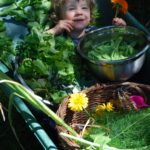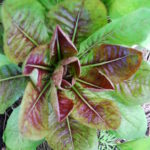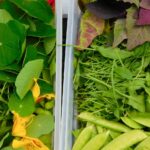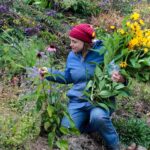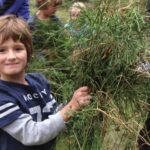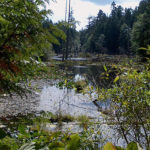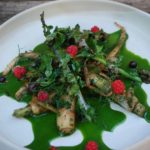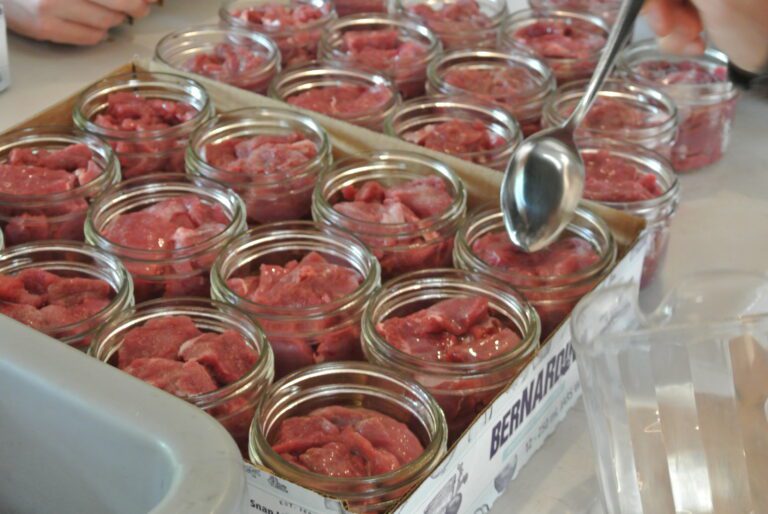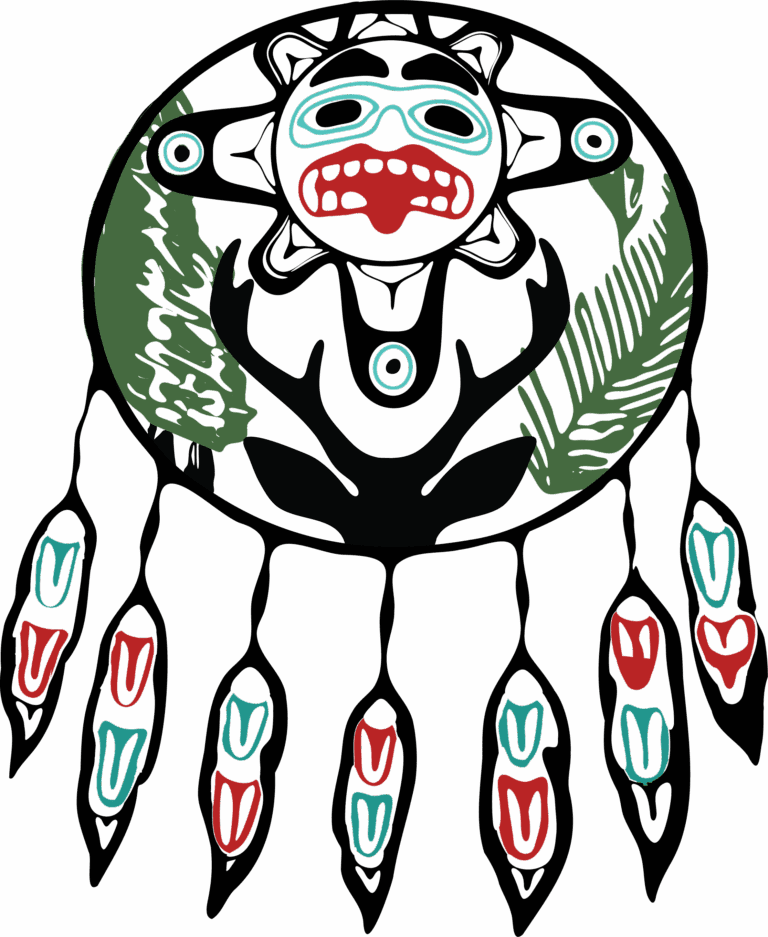The Forest to Table blog documents a unique collaboration between the Galiano Conservancy’s Permaculture Food Forest and renowned Pilgrimme restaurant. This is local 5 star permaculture cuisine.
The Galiano Community Food Forest grows between the ridges of Galiano island, on a plateau where the coastal Douglas fir forest opens to the sun before its cascades as untouched old growth toward cliffs and the ocean. The day is ever changing, sun spackled clouds and rain showers. I am here with food forester Cedana Bourne and graced with the playful presence of her two-year old daughter. We are harvesting strange plants from the food forest to bring to Pilgrimme restaurant, also nestled in the forest just down the island where Chef and co-owner Jesse McCleery will transform them before our eyes.
- The joyful Artimisia
- Radicchio
Pilgrimme restaurant has, since its opening in 2014, become renowned for the creativity with which the freshest wild-crafted and locally grown foods are put together and served in an atmosphere of woodsy sophistication. The pairing of Jesse and co-owner Leanne Lalonde’s Pilgrimme restaurant with the Galiano Conservancy’s Permaculture Food Forest is a combination that speaks to the innovation and uniqueness of Galiano Island.
The food forest is just what it might sound like: It is a forest garden of food producing trees, shrubs, and understory plants. It is planted with perennials that will produce year after year and the forest will eventually cycle its own nutrients and create resilient microclimates beneath its canopy, just as natural forests do. It was created just last year by the Galiano Conservancy to address food security in the face of climate change. The forest is also having the wonderful side effect of expanding the repertoire of what we eat. The diversity of what the GCA is growing has caught the attention of Jesse McCleery and spurred a vibrant relationship. Pilgrimme is one of several restaurants on Galiano Island that buy produce from the Galiano Food Forest.
We show up at Pilgrimme with an assortment of produce including parsley root, oxeye daisy buds, radish pods, sheep sorrel, black radishes, lovage and native nodding onion. After laying it out on a table in their beautiful back patio, Jesse puts us to work shucking peas, but not before serving some delicious craft beer (a saison from Four Winds and Summer Haze Honey Hefe from Hoyne). As we work he and Cedana nibble at the fresh plants.
In the kitchen Jesse gives me a taste of his grand fir vinegar that he is using to replace the use of imported citrus in his cooking; He is working to bring everything closer to home. The kitchen is full of jars of forest edibles pickling and curious ferments. As the parsley roots roast slowly in butter, Jesse juices pea pods to create a sauce that will once again coat the peas from which it came. He shows me sourdough bread that he makes with his own culture and then proceeds to slice a loaf to make some toast on the barbeque.
- The Great Beaver Swamp
I wander out to the back patio to finish my beer and take some notes. A few foraging deer appear in the tall grass and wildflowers and then, before I know it, there is kale on the barbeque, incredibly coloured sauces are being gently poured and dinner is served.
The meal is almost entirely of the food forest. Jesse has used everything we brought him. Peas and radishes with daikon pods in a sauce composed of their own juice, nasturtiums, raw milk and an alpine nostrala cheese for the Kootenai Mountains. On another plate, parsley root roasted in butter with young garlic and nodding onion topped with charred kale in a sauce of juiced lovage, fennel frond and kvass smattered with currants and raspberries. Our salad is greens and buds of oxeye daisy, lettuce, radicchio, and is covered in vibrant wildflower petals, all beautifully balanced by toasted buckwheat and elderflower vinaigrette.
The fresh peas are incredibly tender and in a sauce based around the juice of their own pods have a surprising green and natural sweetness. Among the peas, radishes and daikon seed pods are black radish slices, paper thin and yet shining brightly through to create a texture and landscape of taste that makes you want to explore slowly, to savor each of the unique combinations you find.
The parsley root has a grounded sweetness and a caramelized nuttiness. The root itself is so tender it almost seems to melt. A sauce of lovage, fennel frond and kvass taste like sunshine upon the earthiness of the roots. The young garlic has a gentle fullness that is immersive and warming, the heat of the coming summer days diffusing into evening.
Our salad is an array of bright flavour and colour, the oxeye daisy hints at its wildness, and combined with the malty sprouted buckwheat and radicchio, comes through as a flavour reminiscent of wild liquorish. The elderflower vinaigrette brings an uplifting acidity like light dappled in the forest.
- Roasted parsley root roasted in butter with young garlic and nodding onion
The flavours here are of this place, they are uncontrived and all their own. There is vitality to the food, a sweetness that comes from chlorophyll and notes of the earth that are unique to the ridgeline plateau. Jesse’s skill and inspiration show us the potential of the food forest to be growing, out of resilience and sustainability, a unique culinary culture that embodies these islands; It is both wild and cultivated, brilliant and earthy, found nestled between ridges and valleys and harvested from the rugged landscape where we live.
– Eric Jacobsen
This is the spring installment of the Forest To Table blog and just the beginning! Check back for the next installment as the season changes.
© All Photos and Text copyright the Galiano Conservancy Association
Funding for this project provided by Vancity Envirofund

